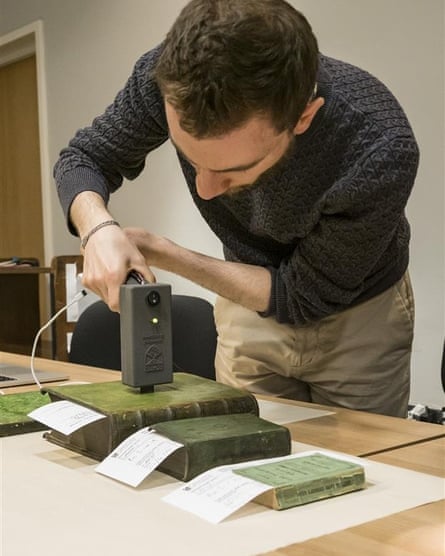Arsenic was historically mixed with copper to create a vivid green for book covers, which can irritate modern day readers,
A new tool to quickly identify books that are poisonous to humans has been developed by the University of St Andrews.
Historically, publishers used arsenic mixed with copper to achieve a vivid emerald green colour for book covers.
While the risk to the public is “low”, handling arsenic-containing books regularly can lead to health issues including irritation of the eyes, nose and throat along with more serious side-effects. The toxic pigment in the book bindings can flake off, meaning small pieces can easily be inhaled.

St Andrews’ device in action. Photograph: University of St Andrews
In recent years, many libraries have prevented access to all suspect green books as a precaution, as testing has until now been costly and time-consuming. For example, the University of Bielefeld, along with several other German universities, isolated 60,000 books as a precautionary measure last year.
The new device can quickly and cheaply detect the presence of toxic pigment. “A device used in the School of Earth Sciences to detect minerals in rocks was the starting point,” said Pilar Gil, who led the research.
“The Eureka moment was discovering the unique reflectance pattern from emerald green pigment in the visible spectrum.
The idea was then to apply this discovery to an instrument which we could use and share with the sector.”
Two scientists from the university’s astronomy and physics school, Graham Bruce and Morgan Facchin, developed a portable tool. “Our device shines different colours of light on to the book,” said Facchin.
“The amount of light reflected at each colour is like a fingerprint of the pigment in the book,” he added. “Through extensive work using books from the university’s collections, our team have found a way to identify the fingerprint of emerald green on a book.”
At St Andrews, emerald green books are stored in Ziploc polythene bags. “When the books are used, we check first if there are any other copies available which are not bound in emerald green,” reads the university’s website.
“If not, the book is handled with special precautions such as the use of nitrile gloves.”
In the 19th century, arsenic and copper were often used to create a vivid green colour for clothing, wallpaper, paint and other products along with book bindings.
“The retention of green books from public view is not only a matter of safety, but it also restricts access to the information contained,” said conservator Erica Kotze, who instigated the project. “This means that the books which have been tested and found not to contain the pigment can remain available to users.”
A free exhibition exploring the project, Poisonous books – Dangers from the past, is running at the Wardlaw Museum in St Andrews until the end of July.
- phen0men4, EnglishLionheart and Mutton
-

 3
3




Recommended Comments
Join the conversation
You can post now and register later. If you have an account, sign in now to post with your account.
Note: Your post will require moderator approval before it will be visible.